

The Human Microbiome. How an 1836 Famine Altered the Genes of Children Born Decades Later. Genomics. Genealogy. Genetics. DNA Analysis Shows That Native American Genealogy Is One of the Most Unique in the World. The suppression of the Native Americans and the decimation of their culture is a black page in the history of the United States.

The discrimination and injustices towards this ancient race, which had lived on the American continent long before the European conquerors came to this land, are still present to this day despite the efforts of different groups and organizations trying to restore the justice. Scientists Finally Admit There Is a Second, Secret DNA Code Which Controls Genes. The fascinating and recent discovery of a new, second DNA code further lends credence to what metaphysical scientists have been saying for millennia — the body speaks two different languages.
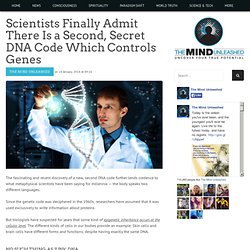
Since the genetic code was deciphered in the 1960s, researchers have assumed that it was used exclusively to write information about proteins. But biologists have suspected for years that some kind of epigenetic inheritance occurs at the cellular level.
DNA - The Double Helix. Scientists discover double meaning in genetic code. Scientists have discovered a second code hiding within DNA.
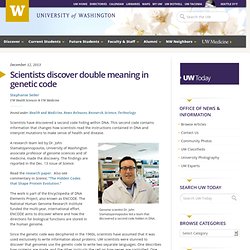
This second code contains information that changes how scientists read the instructions contained in DNA and interpret mutations to make sense of health and disease. High resolutionClick to expand Genome scientist Dr. John Stamatoyannopoulos led a team that discovered a second code hidden in DNA. A research team led by Dr. Read the research paper. DNA - RNA - Protein. The Illustrated Guide to Epigenetics. Illustrations by Joe Kloc This month marks the ten-year anniversary of the sequencing of the human genome, that noble achievement underpinning the less noble sales of 23andMe's direct-to-consumer genetic tests.
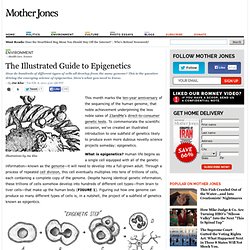
To commemorate the scientific occasion, we've created an illustrated introduction to one subfield of genetics likely to produce even more dubious novelty science projects someday: epigenetics. What is epigenetics? Human life begins as a single cell equipped with all of the genetic information—known as the genome—it will need to develop into a full-grown adult. Genetics and the tree of life. We traditionally think about the tree of life in terms of Kingdoms: plants, animals, fungi, bacteria, etc.
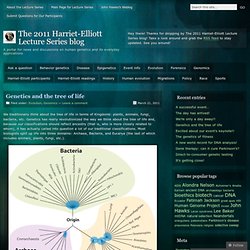
Genetics has really revolutionized the way we think about the tree of life and, because our classifications should reflect ancestry (that is, who is more closely related to whom), it has actually called into question a lot of our traditional classifications. Most biologists split up life into three domains: Archaea, Bacteria, and Eucarya (the last of which includes animals, plants, fungi, etc.). The three domains of life. From Carl Zimmer's blog The Loom. Science writer Carl Zimmer has an interesting post on his blog about how the newest genetic data may even call this classification into question by adding a fourth domain. Genetic Origins. DNA from the Beginning - An animated primer of 75 experiments that made modern genetics.
DNA From The Beginning. Understanding Genetics: Human Health and the Genome. Try your luck at DNA Roulette.

Watch out, you might even learn something...Learn More See whether online genetic tests are right for youLearn More When Will Broccoli Taste Like Chocolate? Learn about our book! Learn More. MendelWeb Homepage 97.1. Genetics Animations. Epigenetics. One example of an epigenetic change in eukaryotic biology is the process of cellular differentiation.
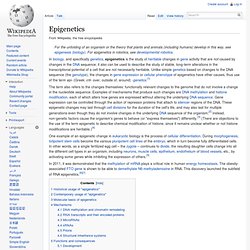
During morphogenesis, totipotent stem cells become the various pluripotent cell lines of the embryo, which in turn become fully differentiated cells. In other words, as a single fertilized egg cell – the zygote – continues to divide, the resulting daughter cells change into all the different cell types in an organism, including neurons, muscle cells, epithelium, endothelium of blood vessels, etc., by activating some genes while inhibiting the expression of others.[5]
Genetics. Bioinformatics. Map of the human X chromosome (from the NCBI website). Assembly of the human genome is one of the greatest achievements of bioinformatics. Bioinformatics i/ˌbaɪ.oʊˌɪnfərˈmætɪks/ is an interdisciplinary scientific field that develops methods for storing, retrieving, organizing and analyzing biological data. A major activity in bioinformatics is to develop software tools to generate useful biological knowledge. Bioinformatics is a distinct science from biological computation, the latter being a computer science and computer engineering subfield using bioengineering and biology to build biological computers, whereas bioinformatics simply uses computers to better understand biology. Introduction[edit] History[edit] Sequences. Genomes. Goals[edit] In order to study how normal cellular activities are altered in different disease states, the biological data must be combined to form a comprehensive picture of these activities.
Approaches[edit] Major research areas[edit] Sequence analysis[edit] Gene. Physical definitions[edit] RNA genes and genomes in the world[edit] When proteins are manufactured, the gene is first copied into RNA as an intermediate product.

Learn.Genetics™ Central Dogma Of Dna.